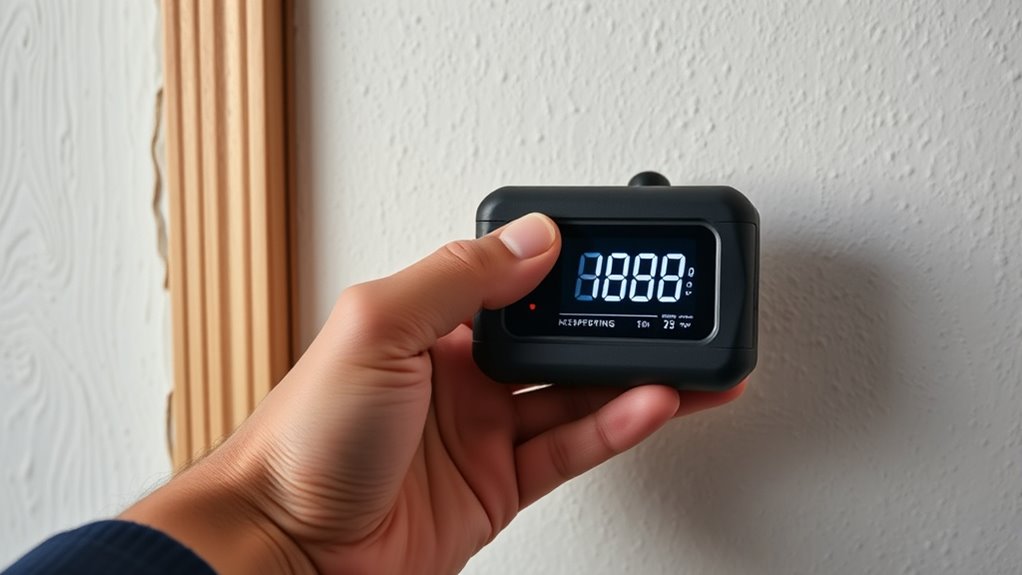If you’re looking for the most accurate stud finders in 2025, I recommend models like Franklin Sensors ProSensor MAX and M210, which offer multiple sensors and deep detection up to 2.5 inches, making pinpointing studs dependable. The DEWALT DW0100 provides clear LED guidance, while wall scanners like the 5-in-1 detect multiple materials with safety alerts. If you want to guarantee precision in your projects, keep exploring the top options that match your needs.
Key Takeaways
- Advanced sensors and detection depths up to 2.5 inches ensure precise wall stud identification.
- User-friendly features like LED displays, audible alerts, and automatic calibration simplify accurate detection.
- Multi-material detection capabilities for studs, metal, pipes, and live wires enhance safety and versatility.
- Durable, ergonomic designs suitable for DIYers and professionals improve confidence in locating studs.
- Reputable brands offer reliable, high-accuracy models with modern features for confident wall scanning in 2025.
Franklin Sensors Prosensor M210 Stud Finder

If you’re looking for a stud finder that offers superior accuracy, the Franklin Sensors Prosensor M210 is an excellent choice. It uses 13 patented sensors to detect wood and metal studs more precisely, with a deep scan that adjusts automatically for material, texture, and up to 1.7 inches depth. The wide LED display shows both the center and edges of studs simultaneously, making detection clear and reliable. It also features a live wire meter, ensuring safety by detecting electrical wires before drilling. Made in the USA, this durable tool is trusted by DIYers and professionals alike for its consistent performance and accuracy.
Best For: DIY homeowners and professional contractors seeking highly accurate stud detection with safety features and durable construction.
Pros:
- Uses 13 patented sensors for precise detection of wood and metal studs
- Features a wide LED display that shows both the center and edges of studs simultaneously
- Built-in live wire meter enhances safety by detecting electrical wires inside walls
Cons:
- Slightly more expensive than basic stud finders due to advanced technology
- May require some familiarization with its sensor readings for optimal use
- Larger size might be less portable compared to compact models
Franklin Sensors ProSensor M150/X990 Stud Finder

Looking for a stud finder that delivers unbeatable precision? The Franklin Sensors ProSensor M150/X990 is a game-changer. With nine sensors, it detects the full width of studs, including edges and centers, ensuring pinpoint accuracy. Its LED indicators clearly show full studs, double studs, and irregular formations, turning red toward the stud and green when centered. It can locate studs up to 1.5 inches deep through drywall and detects both wood and metal with high reliability. No calibration is needed—just press and scan. Lightweight and user-friendly, it’s perfect for DIYers and pros who demand dependable, precise wall measurements every time.
Best For: DIYers and professionals seeking highly accurate, reliable stud detection with easy operation and safety features.
Pros:
- Features 9 sensors for precise detection of full stud width, edges, and centers
- No calibration required; simple press and scan operation
- LED indicators clearly display stud type, position, and live wire warnings
Cons:
- Requires 2 AAA batteries (not included), which are not rechargeable
- May have difficulty detecting studs in exterior walls with insulation or metal mesh
- Durability on hard drops is untested, potentially affecting long-term use
The Original StudBuddy Magnetic Stud Finder
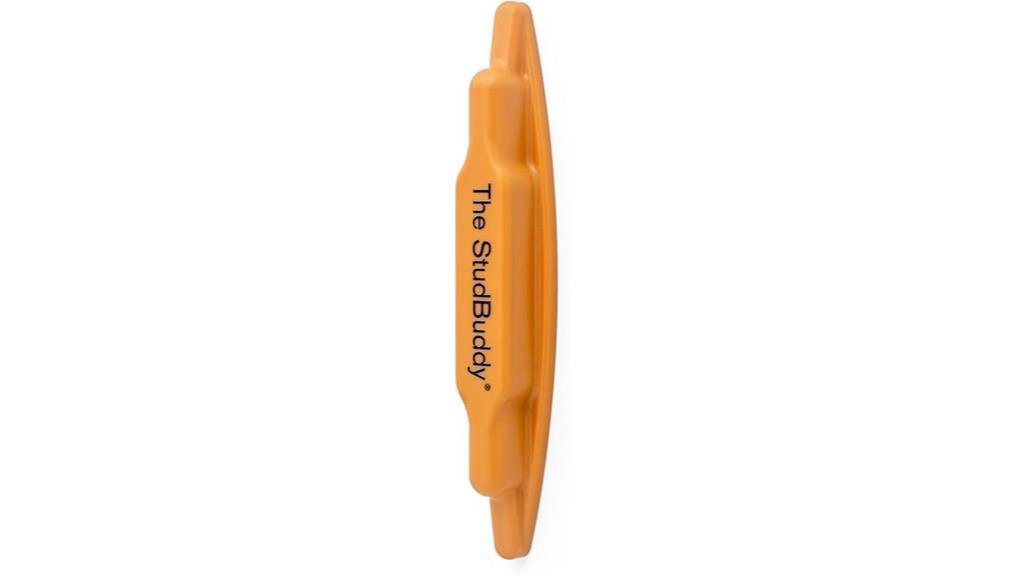
The Original StudBuddy Magnetic Stud Finder is an excellent choice for anyone seeking a simple, reliable tool to locate wall studs quickly without the need for batteries or calibration. Made in the USA, it uses powerful neodymium magnets to detect screw or nail heads in drywall and wood surfaces. Its straightforward design means no moving parts, making it durable and easy to use. Simply scan the wall, and the magnet will stick when it finds a nail or screw, pinpointing the stud’s location. It’s ideal for quick, accurate results on drywall and wood, though it’s not suitable for lath and plaster walls.
Best For: DIY homeowners and renters seeking a simple, battery-free tool to quickly locate wall studs in drywall and wood surfaces.
Pros:
- No batteries or calibration required, always ready to use
- Durable, with no moving parts for long-lasting reliability
- Easy to operate with straightforward wall scanning to find studs quickly
Cons:
- Not suitable for lath and plaster walls
- Magnetic detection may be less precise on uneven or textured surfaces
- Limited to drywall and wood, restricting use on other wall types
DEWALT Stud Finder (DW0100)
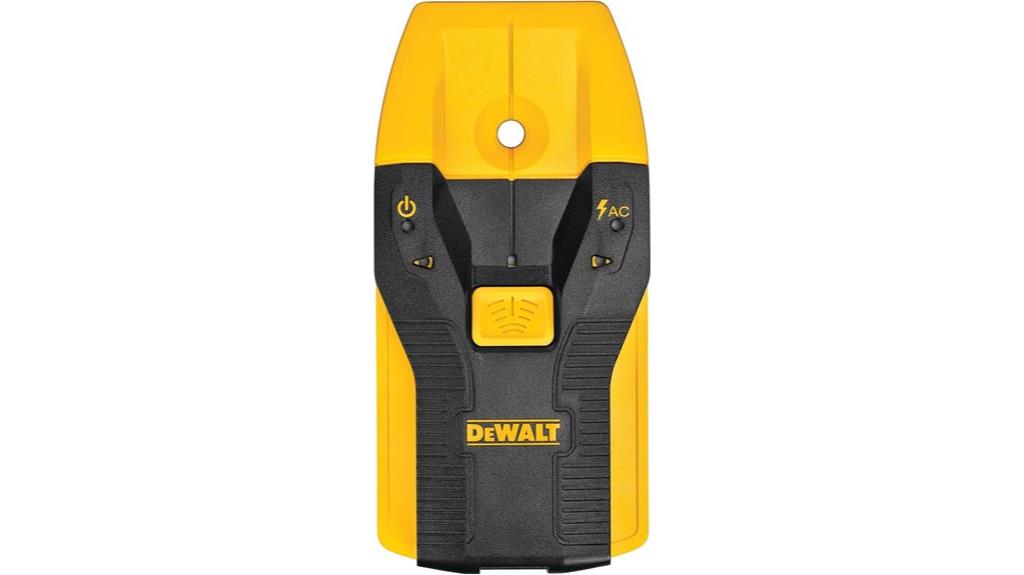
For anyone seeking precise and reliable stud detection, the DEWALT Stud Finder (DW0100) stands out with its center-find technology that accurately locates stud centers. It can detect framing studs up to 3/4 inches deep in wood and metal, ensuring versatility across projects. The device features constant auto-calibration for quick, dependable operation and a center marking channel for easy, precise marking. Its slim profile makes it comfortable to handle and store. Visual LED arrows and audible alerts guide you to stud locations clearly. With AAA batteries included, it’s ready to use right out of the box, combining safety, accuracy, and convenience in a compact design.
Best For: DIY enthusiasts, carpenters, and contractors seeking a reliable, easy-to-use stud finder for various construction projects.
Pros:
- Accurate center-find technology for precise stud location
- Detects studs in wood and metal up to 3/4 inches deep
- Visual and audible alerts for clear guidance
Cons:
- Limited to detecting studs up to 3/4 inches deep, which may not suit thicker walls
- Requires AAA batteries, which may need replacement over time
- Slim profile might be less durable if handled roughly
Stud Finder Wall Scanner 5-in-1

If you need a reliable tool that can detect multiple materials behind walls, the Stud Finder Wall Scanner 5-in-1 is an excellent choice. It quickly locates wood, metal, pipes, joists, and live wires with an upgraded intelligent chip and high-definition LCD display. The device offers multiple scan modes—Stud, Metal, AC—covering different depths and materials. Its bright screen, audio alerts, and safety indicators make it easy to interpret results and avoid hazards. With automatic calibration and ergonomic design, this scanner is simple to use for professionals and DIYers alike, ensuring accurate detection and safer wall-mounted projects.
Best For: homeowners, DIY enthusiasts, and professionals seeking a reliable multi-material wall scanner for accurate detection of studs, metals, pipes, and live wires.
Pros:
- Rapid and precise detection of various materials with upgraded intelligent chip
- User-friendly with automatic calibration and ergonomic design for comfortable operation
- Multiple scan modes and safety indicators, including live wire detection, for versatile use and safety
Cons:
- Performance can be affected by electromagnetic interference or uneven wall surfaces
- Requires proper storage and handling of batteries to maintain functionality and lifespan
- May have limited detection depth for certain materials depending on wall thickness
Stud Finder Wall Scanner (Tangerine)
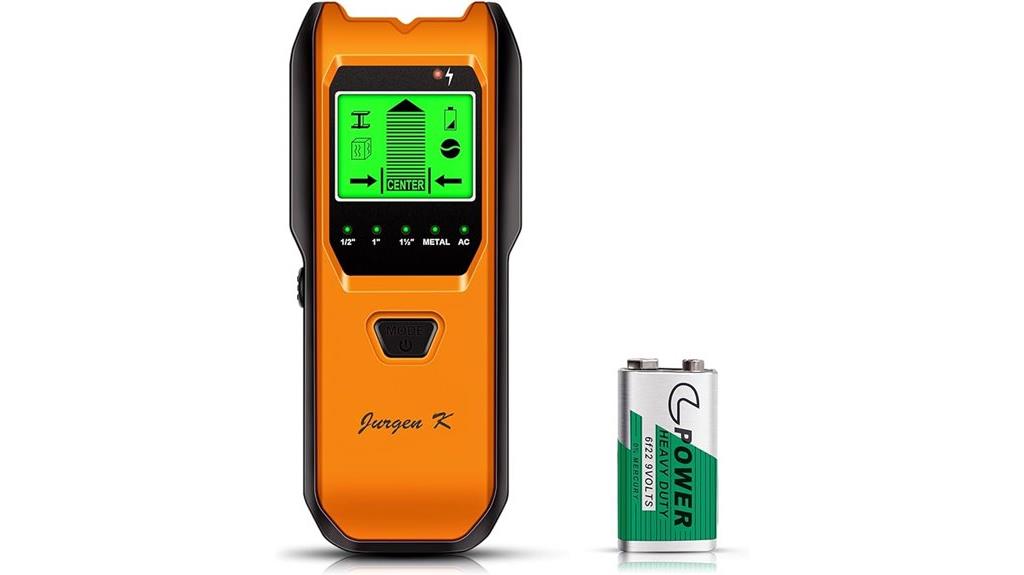
A standout feature of the Jurgen K Stud Finder Wall Scanner (Tangerine) is its multifunctionality, making it ideal for DIY enthusiasts, homeowners, or professionals who need reliable detection of studs, pipes, and live wires behind various wall surfaces. It’s a versatile 5-in-1 device with upgraded smart sensors, HD LCD display, and audio alarms that deliver quick, accurate results. It can detect studs at different depths, as well as metal pipes and live electrical wires, even through wallpaper, paint, or tiles. Its intuitive calibration and visual cues make it easy to use, ensuring safe and efficient wall inspections every time.
Best For: DIY enthusiasts, homeowners, and professionals seeking a reliable, multifunctional wall scanner for accurate detection of studs, pipes, and live wires behind various wall surfaces.
Pros:
- Accurate detection of studs, metal pipes, and live electrical wires at multiple depths
- User-friendly with intuitive calibration, HD LCD display, and audio alerts
- Versatile 5-in-1 functionality suitable for different surfaces and applications
Cons:
- Occasional calibration issues requiring multiple attempts for optimal accuracy
- Limited effectiveness in detecting wires in highly complex or cluttered environments
- Battery life may be limited, necessitating replacement after extensive use
Franklin Sensors ProSensor MAX Stud Finder with 13 Sensors

The Franklin Sensors ProSensor MAX Stud Finder with 13 sensors stands out as the top choice for professionals and serious DIYers who demand pinpoint accuracy. Its 13 sensors provide unmatched detection precision, even through walls up to 2.5 inches thick. The wide LED display shows both the center and edges of studs, making it easy to identify single, double, or irregular studs. No calibration is needed—just press and scan—saving time and effort. With features like multiple detection modes and a durable build, this tool is reliable for complex wall structures, ensuring you find studs confidently every time.
Best For: professional contractors and serious DIYers who require precise stud detection through complex wall structures.
Pros:
- Features 13 sensors for maximum accuracy and detection depth up to 2.5 inches.
- Wide LED display shows both the center and edges of studs, accommodating various stud configurations.
- No calibration required; easy to use with quick, reliable scans even over existing studs.
Cons:
- Requires two AA batteries (not included), which may be an additional purchase.
- Bulkier design compared to compact point sensors, potentially less convenient for tight spaces.
- May be more expensive than basic stud finders, which could be a consideration for casual users.
Stud Finder Wall Scanner with LCD Display and 5-in-1 Detection
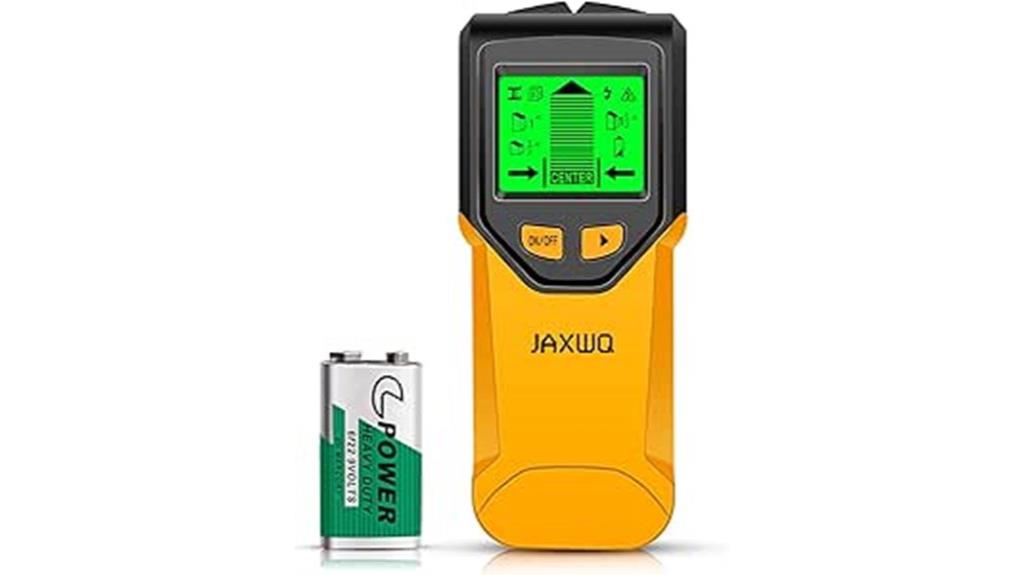
For anyone seeking precise wall detection, the Stud Finder Wall Scanner with LCD Display and 5-in-1 Detection stands out as an excellent choice. It uses an intelligent micro-sensor chip with high sensitivity, quickly identifying studs, metal, pipes, joists, and live wires behind walls, floors, or ceilings. Its multiple scan modes—stud, deep, and metal—offer versatility for different materials and depths. The bright backlit HD LCD display clearly shows object locations, edges, and centers, while visual cues and audio alerts guide me during use. This tool guarantees safer, more accurate installations, making it ideal for DIYers, homeowners, and professionals alike.
Best For: DIY enthusiasts, homeowners, and professionals seeking accurate and versatile wall detection for safe and efficient installation or repair projects.
Pros:
- High sensitivity micro-sensor chip for precise detection of studs, metal, pipes, and live wires
- Multiple scan modes (stud, deep, metal) enhance versatility across various materials and depths
- Bright backlit HD LCD display with visual cues and audio alerts for easy use in all lighting conditions
Cons:
- May require some initial familiarization with different scan modes for optimal use
- Potentially limited detection range for extremely deep or hidden objects depending on wall material
- Battery life could be a concern with frequent use in large projects
5-in-1 Stud Finder Wall Scanner

If you’re looking for a reliable tool to locate studs, pipes, and live wires behind walls, the 5-in-1 Stud Finder Wall Scanner is an excellent choice. It offers multiple detection modes, including deep scans for wood, metal, and AC wiring up to 2 inches deep. Its precision-engineered chip ensures fast, stable readings, while the upgraded LCD display makes it easy to interpret results—even in low light. The one-button operation simplifies calibration and switching modes, and audio alerts confirm when objects are found. Overall, it’s user-friendly and versatile, ideal for safely and accurately mounting heavy items or installing fixtures.
Best For: DIY homeowners and professionals seeking a versatile, accurate wall scanner for safe installation and mounting projects.
Pros:
- Multiple detection modes for metal, wood, pipes, and live wires, enhancing safety and versatility.
- Upgraded LCD display and audio alerts for easy interpretation of results, even in low-light conditions.
- Simple one-button operation with straightforward calibration, making it user-friendly for all skill levels.
Cons:
- Some users report inconsistent detection accuracy or false positives, especially on certain wall types.
- Calibration can sometimes be challenging, leading to unreliable readings if not done properly.
- Limited customer support contact options, which may cause frustration if issues arise.
CRAFTSMAN Stud Finder, 3/4-Inch Depth (CMHT77633)

Craftsmen and DIY enthusiasts seeking a reliable, easy-to-use stud finder will appreciate the CRAFTSMAN CMHT77633. This compact device detects studs up to ¾-inch deep, suitable for drywall, wallpaper, or fabric-covered surfaces. Its edge detection helps locate stud edges of wood and metal, with a shock- and water-resistant plastic body for durability. Weighing only 3.2 ounces, it’s portable and simple to operate—just press the side button and swipe across the wall. While some users experience occasional false positives, overall, it offers solid accuracy for light household tasks like hanging shelves or curtains. Plus, it comes with a full lifetime warranty for added peace of mind.
Best For: DIY homeowners and craft enthusiasts seeking an affordable, easy-to-use stud finder for light household projects on drywall, wallpaper, or fabric-covered surfaces.
Pros:
- Compact, lightweight design weighing only 3.2 ounces for easy handling and portability
- Reliable detection of studs up to ¾-inch deep with clear visual and audible signals
- Durable, shock- and water-resistant plastic body suitable for various wall surfaces
Cons:
- Occasional false positives or inconsistent detection, especially on complex wall structures
- Requires a 9V battery (not included), adding to the initial setup cost
- Less suitable for professional or heavy-duty use due to potential sensitivity issues
Franklin Sensors ProSensor M90 Wall Scanner with 9 Sensors
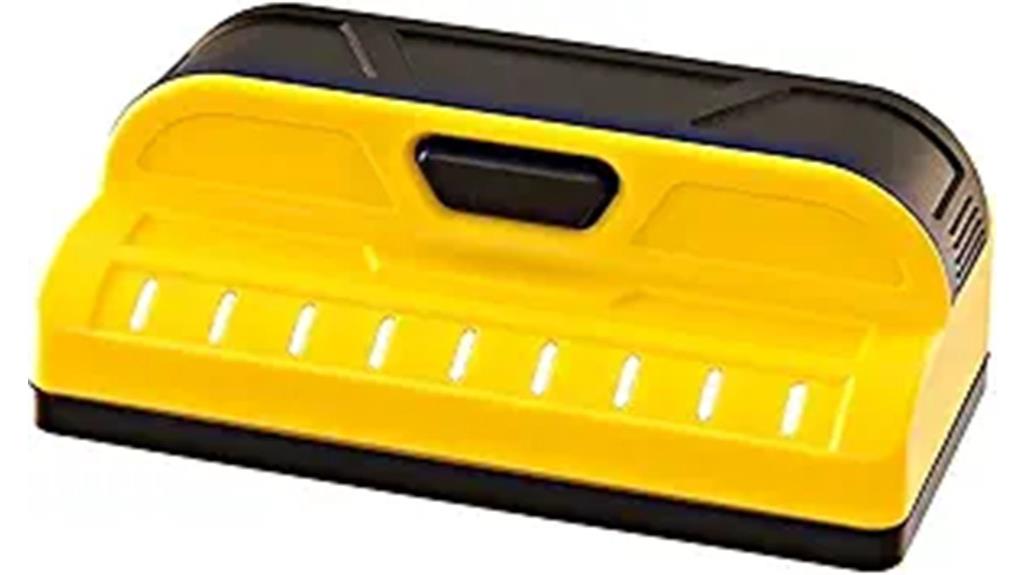
The Franklin Sensors ProSensor M90 Wall Scanner stands out as the top choice for anyone who needs pinpoint accuracy when locating studs. With 9 sensors, it’s the most precise model I’ve used, detecting both wood and metal studs instantly without calibration. Its full-width LED display clearly shows stud centers and edges, making it easy to mark exact locations. It scans up to 1.5 inches deep through drywall or plaster, providing reliable results every time. Lightweight and ergonomic, it’s simple to operate—just press and hold. Overall, the ProSensor M90 offers professional-level precision, making it ideal for hanging heavy items or detailed projects.
Best For: DIY homeowners and professionals seeking the most accurate and reliable stud detection for precise mounting and hanging projects.
Pros:
- Highly accurate with 9 sensors for precise detection of wood and metal studs
- Full-width LED display clearly shows stud centers and edges for easy marking
- No calibration needed, simple one-button operation with instant results
Cons:
- Requires two AAA batteries (not included), adding extra step for setup
- Does not detect live wires, which may be a concern for electrical safety
- Slightly more expensive than basic single-sensor models, but offers greater precision
Rechargeable Wall Stud Finder with HD LCD and Voice

A rechargeable wall stud finder with an HD LCD and voice alerts is ideal for both DIY enthusiasts and professionals who need quick, reliable wall scanning. It detects wood studs, metal studs, pipes, and live AC wires, ensuring safe drilling and hanging. With advanced sensors, it offers precise edge and center detection across multiple modes, including metal, AC, and wood scans. No calibration is needed—just press and hold to scan. Its rechargeable battery lasts up to five hours, and the lightweight design makes it easy to handle. Plus, the HD display and voice alerts simplify operation, making it a practical tool for any wall project.
Best For: DIY enthusiasts and professionals seeking a reliable, rechargeable wall scanner for accurate detection of studs, pipes, and live wires.
Pros:
- Rechargeable battery provides up to 5 hours of continuous use, eliminating the need for frequent replacements.
- HD LCD display and voice alerts make operation straightforward and user-friendly.
- No calibration required—simply press and hold to scan, suitable for both beginners and experienced users.
Cons:
- Slight inaccuracies reported by some users, which may require double-checking with other tools.
- Limited detection depth for certain materials, such as metal or wood beyond specified scan ranges.
- Plastic construction, while lightweight, might be less durable under heavy or rough handling.
Stud Finder Wall Scanner Detector (5-in-1)

If you’re looking for a reliable wall scanner that combines multiple detection capabilities into one device, the Stud Finder Wall Scanner Detector (5-in-1) is an excellent choice. It detects wood and metal studs, pipes, and live AC wires with high accuracy using advanced sensors. The device features a bright LCD display, audio alerts, and a durable, dust-resistant body suitable for professionals and DIYers alike. It can locate edges and centers of studs and wiring up to 2 inches deep, helping you avoid costly mistakes. Its versatility and ease of use make it a top pick for safe, precise wall scanning in 2025.
Best For: DIY homeowners and professionals seeking a versatile, accurate wall scanner for safely locating studs, pipes, wiring, and metal in various wall types.
Pros:
- High-precision detection of wood, metal studs, pipes, and live AC wires up to 2 inches deep
- User-friendly with bright LCD display, audio alerts, and durable dust-resistant body
- Effective for locating edges and centers, reducing the risk of accidental damage during drilling
Cons:
- Some users report false positives or inconsistent live wire detection
- Sensitivity to static electricity or improper calibration can affect accuracy
- Occasional slow response times or difficulty distinguishing wires from false signals
Franklin Sensors Prosensor T6 Stud Finder

For those seeking highly accurate drywall detection, the Franklin Sensors Prosensor T6 Stud Finder stands out because of its six-sensor design, which provides superior precision compared to traditional models. This tool is specifically crafted for interior drywall, offering a detection depth of up to 1.5 inches. Its six sensors work together to display both the center and edges of studs simultaneously, reducing missed detections. The device is easy to use—simply press and hold the button to scan, with no calibration needed. The LED indicators give clear visual signals, making locating studs quick and reliable, perfect for precise interior projects.
Best For: DIY homeowners and professionals seeking highly accurate drywall stud detection with minimal false readings.
Pros:
- Features six sensors for enhanced accuracy and reliable detection.
- Displays both the center and edges of studs simultaneously for precise locating.
- Easy to operate with no calibration required—simply press and hold to scan.
Cons:
- Designed exclusively for drywall and not suitable for stucco, concrete, or brick.
- Requires two AAA batteries, which are not included.
- Limited to a maximum detection depth of 1.5 inches, not suitable for thicker materials.
Factors to Consider When Choosing Stud Finders for Accuracy
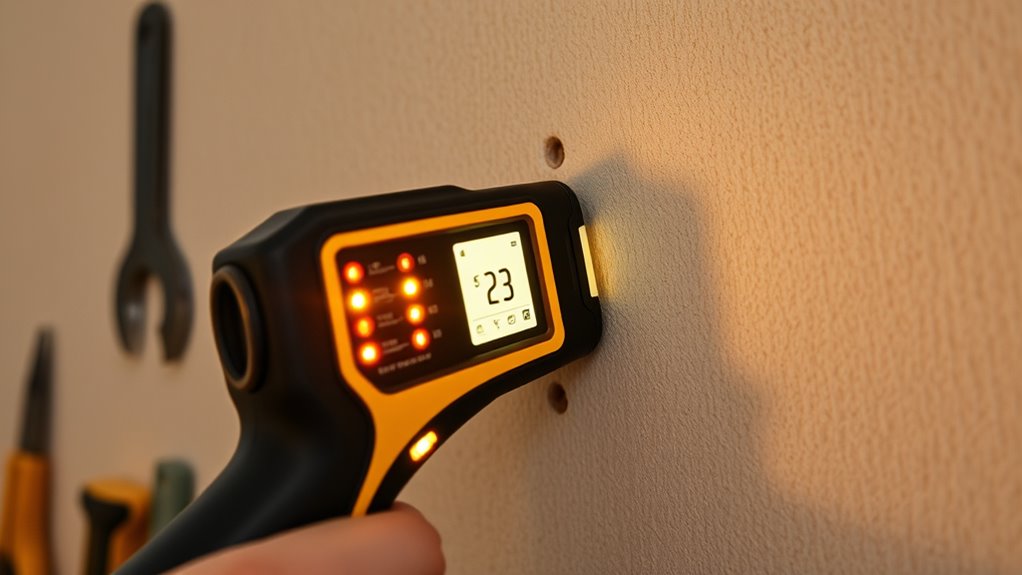
When selecting a stud finder, I consider factors like sensor quantity and placement to guarantee accurate detection. I also look at the detection depth range and wall material compatibility to match my projects. Additionally, safety features and calibration needs play a key role in choosing the right device for reliable results.
Sensor Quantity and Placement
The number and placement of sensors in a stud finder are crucial factors that directly affect its ability to detect studs accurately. Devices with multiple sensors—often nine or more—offer full-width visualizations of studs, making it easier to identify edges and centers precisely. Proper sensor placement across the device’s surface ensures thorough coverage, regardless of wall material or stud orientation, reducing the chance of missed detections. Higher sensor counts also enable detection at greater depths, typically up to 2.5 inches, depending on wall thickness. When sensors are strategically arranged, they can simultaneously pinpoint both edges and centers, minimizing false positives and boosting confidence during wall scanning. This thoughtful configuration markedly enhances overall accuracy and reliability.
Detection Depth Range
Choosing a stud finder with the right detection depth range is essential to guarantee it can locate studs behind various wall types. The detection depth indicates how deep the device can accurately identify studs, usually measured in inches. Most models can detect studs up to 1.5 to 2.5 inches deep, but some offer greater ranges for thicker walls or insulation. Knowing the maximum detection depth helps ensure the tool suits your specific wall material and project needs. Keep in mind that wall composition affects performance; dense surfaces or metal can reduce effective range. Selecting a stud finder with appropriate depth capabilities ensures you don’t miss studs hidden behind multiple drywall layers or insulation, making your DIY projects more precise and efficient.
Wall Material Compatibility
Wall material plays a crucial role in how accurately a stud finder can detect studs, so it’s important to contemplate this factor before making a purchase. Different surfaces like drywall, plaster, brick, or lath and plaster can markedly impact performance. Stud finders designed for drywall may struggle behind thicker or denser materials such as brick or concrete unless they have specialized sensors. Surfaces with insulation, stucco mesh, or metallic coatings can interfere with electronic models, reducing their accuracy. Magnetic stud finders are unaffected by wall material but rely on nails or screws, which may be hidden or absent in some constructions. To guarantee reliable detection, choose a stud finder explicitly compatible with your wall type and consider models with advanced sensors for challenging surfaces.
Calibration Requirements
Automatic calibration features make it easier to achieve consistent, accurate readings because they eliminate the need for manual adjustments. With these tools, you don’t have to worry about placing the device flat against the wall or pressing buttons repeatedly—each time you turn it on, it calibrates itself instantly. This reduces user error and speeds up the process, especially when working with different wall types or materials. In contrast, models that require manual calibration can be tricky; improper setup might lead to false positives or missed studs, which can be frustrating. Choosing a stud finder with automatic calibration ensures reliable detection every time and minimizes mistakes, making your wall scanning faster, simpler, and more precise.
Safety Features Included
Safety features are essential components to take into account when selecting a stud finder, as they can greatly reduce the risk of electrical accidents during installation or wall scanning. Live wire detection is a key safety feature that warns you of hidden electrical cables, often using LEDs or audible alerts. This helps prevent accidental drilling into energized wires, minimizing shock hazards and wall damage. Multiple safety alerts, such as visual indicators and sound alarms, further enhance awareness of potential hazards. Choosing a stud finder with integrated safety features guarantees safer operation, especially in walls with complex wiring or unknown electrical setups. Prioritizing these features helps protect both the user and the property, making safety an integral part of your tool selection process.
Display Clarity and Indicators
When selecting a stud finder, clear display clarity and effective indicators can make a significant difference in accuracy. A backlit LCD screen ensures I can see the readings clearly, even in dim lighting. Visual cues like LED arrows or color-coded lights offer intuitive guidance, helping me quickly identify stud edges and centers without guesswork. Full-width LED displays that show both edges and centers at once improve detection precision over simple point sensors. Audible alerts are also helpful, confirming stud detection without needing constant visual focus. Well-designed indicators reduce false positives and boost my confidence, especially when dealing with complex or layered walls. Overall, a clear, informative display combined with reliable indicators makes the process more accurate and straightforward.
Ease of Operation
Choosing a stud finder that’s easy to operate can considerably improve your chances of accurate detection. Look for models with automatic calibration—these eliminate the hassle of manual adjustments before each use, saving you time and frustration. A simple one-button operation allows for quick activation and scanning, making the process straightforward even for beginners. Clear visual indicators, such as LED lights or LCD screens, help you interpret results instantly without second-guessing. An ergonomic, lightweight design reduces fatigue and makes handling comfortable during extended use. Additionally, audible alerts or beeps provide immediate feedback, so you don’t have to keep an eye on the display constantly. Overall, user-friendly features ensure a smooth, efficient experience, increasing your confidence in finding studs accurately.
Frequently Asked Questions
How Do Different Stud Finders Detect Electrical Wiring Behind Walls?
Different stud finders detect electrical wiring by sensing changes in electromagnetic fields or density within the wall. I’ve found that electronic models with deep scanning capabilities use sensors to identify live wires, alerting me with visual or audible signals. Magnetic stud finders, on the other hand, detect nails or screws embedded in the studs, but they’re less effective for wiring. I always double-check with multiple tools for added safety.
Which Stud Finder Types Are Best for Irregular or Textured Wall Surfaces?
If you’re dealing with irregular or textured walls, I recommend using a multi-sense or combo stud finder. These models use both magnetic and electronic sensors, which helps them adapt to uneven surfaces and detect studs behind tricky textures. I’ve found that they’re more reliable on rough or uneven walls because they can pick up both metal and changes in wall density, giving you more confidence when marking your studs.
How Does the Depth Detection Vary Among Top Models in 2025?
Depth detection varies quite a bit among top models in 2025. Some find studs up to 1.5 inches deep, ideal for drywall, while others can detect up to 4 inches or more, perfect for thicker walls or concrete. I’ve found that higher-end models often feature multi-depth settings, allowing me to choose the right detection level. This flexibility helps guarantee I locate studs accurately, even in challenging wall types.
Are There Specific Features That Improve Accuracy in Stud Finders?
Yes, there are specific features that boost accuracy in stud finders. I look for models with multi-sense technology, which detects both density and magnetic fields. Deep scanning capabilities help locate studs behind thicker walls. Additionally, features like LED indicators, audio alerts, and calibration functions guarantee I get precise readings. These enhancements reduce false positives and give me confidence when hanging or installing, making my projects smoother and more accurate.
How Do Magnetic and Electronic Stud Finders Compare in Precision?
Magnetic stud finders are generally less precise because they rely on metal objects, which can sometimes be misleading. Electronic stud finders, on the other hand, tend to be more accurate since they detect changes in density within the wall. I find electronic models better for pinpointing studs, especially in thicker or irregular walls. However, magnetic finders are simpler and work well when you just need a quick, rough location.
Conclusion
When choosing a stud finder, I recommend considering accuracy, ease of use, and whether it offers additional features like deep scanning or magnetic detection. My top picks help me confidently locate studs for any project, big or small. With the right tool, I avoid guesswork and make my DIY tasks safer and more precise. Trust me, investing in a quality stud finder pays off, making your home improvement projects smoother and more successful.
